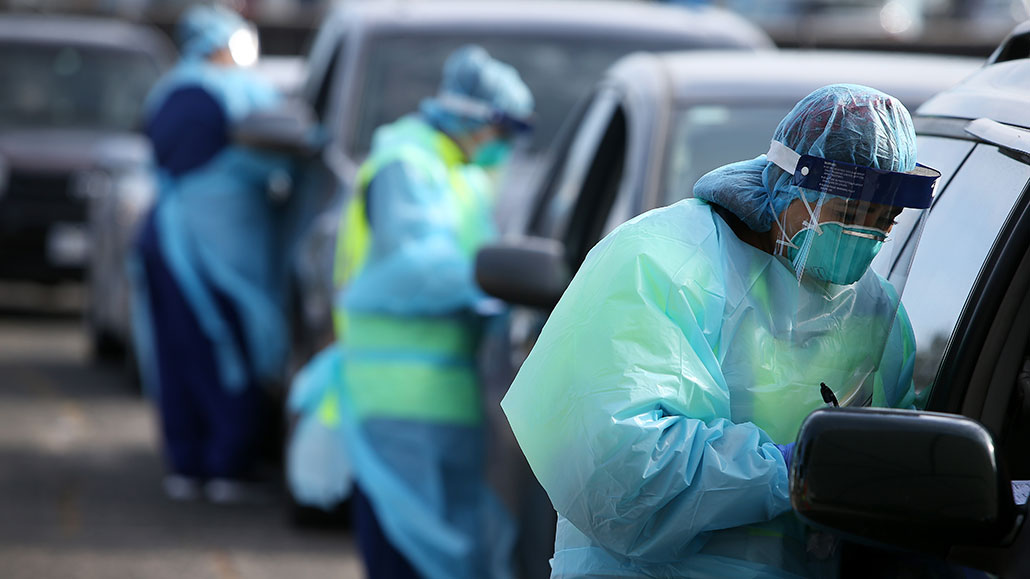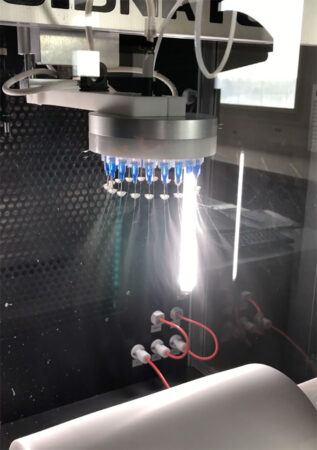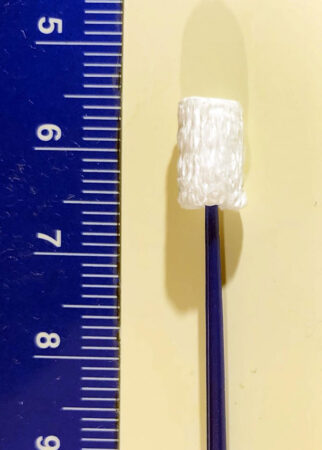Super-absorbent swab could curb errors in COVID-19 testing
Fewer false-negative results could limit spread of the coronavirus

Healthcare workers use nasal swabs to conduct COVID-19 testing at a drive-up site. If someone’s result wrongly comes back negative, that person could unknowingly keep spreading the virus.
Lisa Maree Williams/Getty Images News
Most COVID-19 tests use a swab to collect material from inside someone’s nose. The results guide whether people should quarantine to prevent the spread of disease. If a test wrongly comes back negative, though, that’s a problem. People might think they’re virus-free when they aren’t. That means they could still spread the disease to others.
Jingwei Xie is a chemical and biomolecular engineer. He works at the University of Nebraska Medical Center in Omaha. He is part of a team that has invented a new type of swab. It absorbs better than cotton or flocked swabs. (Flocked swabs have fibers that stick out sideways. They look like bottle brushes under a microscope.) More importantly, the new swab also gave fewer false-negative results in lab tests for the SARS-CoV-2 virus. That the virus that causes COVID-19.
Xie’s group described its work in ACS Nano Letters on January 27.
The Nebraska researchers have worked on nanofiber materials for more than 10 years. The fibers’ diameter is measured in billionths of a meter. Such small-scale materials can perform a host of benefits. For instance, they can boost drug delivery within the body and help repair or replace damaged tissues. When the COVID-19 pandemic hit, Xie’s team thought about how to help.

“At the beginning of the pandemic, there was a lack of a sufficient amount of swabs for diagnostics,” Xie says. Many groups therefore looked to innovate and invent new swabs.
Xie’s team built on some of its past successes. It had shown how to form nanofibers into spheres, cylinders and cones. They now use a similar process to make its fibers for its super-absorbent swabs. The fibers’ diameter is about 500 nanometers (two hundred-thousandths of an inch). A strand of hair from a young adult will tend to be 140 to 180 times thicker than that. (Averages vary depending on ethnicity.)
Nanofibers are actually produced by a process known as electrospinning. It starts with a dissolved biodegradable polymer plastic. This solution drips out of needles attached to a disk on a machine. That machine applies a high voltage to the needles’ tips. The force of the resulting electric field overcomes the droplets’ surface tension — the attraction of the liquid’s molecules that held them together. That makes nanofibers shoot out from the needles onto a spinning drum that catches them underneath.
The mat of fibers coming off the drum afterward has a thickness of about 1 millimeter (four hundredths of an inch). It looks just like a piece of paper.
The next step is making that into a 3-D material. The team submerges the mat in liquid nitrogen and then cuts it into squares. Those squares then spend a day bubbling in a chemical solution. That forces the material into a 3-D form. After that, the team adds a gelatin-based coating to the fibers. That forms a network of chemical bonds with the material to hold the new 3-D structure in place.
Put to the test

The team bonded little cylinders of the new material to the ends of plastic sticks. Then it tested these new swabs against both cotton and flocked ones made from polyester. The new swabs’ nanofibers have more surface area to wick up any liquid. They’re also much more porous. “They’re so much more absorptive than the other two swab types that it’s not even close,” Xie says.
The group also tested the ability of all these swabs to detect the virus that causes COVID-19. At the lowest concentrations of virus used, the new swabs outperformed both cotton and flocked swabs. That difference could make a big difference when it comes to getting accurate results.
The most reliable tests for COVID-19 use a lab process called PCR. It can detect virus fragments in a sample and then make many copies of those bits. If the amount of virus a swab collects is too small, it might not register. Then the test can falsely report no virus.
“A swab that better collects even small amounts of virus should limit this problem,” says Colin West. He’s a doctor at the Mayo Clinic in Rochester, Minn., and did not work on the swab project. “The lab results are intriguing,” he notes. “But what really matters is how this works in real life.” Those tests are not easy, he adds. But they’re “critically important.” Tests like that would be the next step for Xie’s team.
When the results come back wrong, infected people might not quarantine as they should.
“The reality is that in medicine no test is perfect,” West says. He and colleagues explained why in Mayo Clinic Proceedings last April. It’s unclear exactly how many negative test results for COVID-19 are wrong, but estimates range upwards from around 10 percent. Yet in a large city, even a small error rate can lead to thousands more cases for an easily spread disease like COVID-19.
“At the individual level, [even] 1 percent might not seem like very much,” West says. “But when you’re talking about a big city or a country or the world, you’re talking about a lot of people. And that matters.” That’s why people still need to mask up, use physical distancing, wash hands often and avoid crowds.
This is one in a series presenting news on technology and innovation, made possible with generous support from the Lemelson Foundation.







